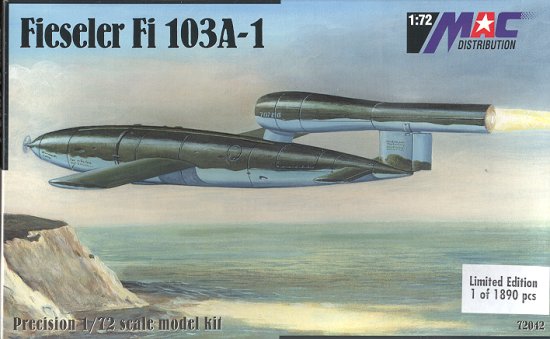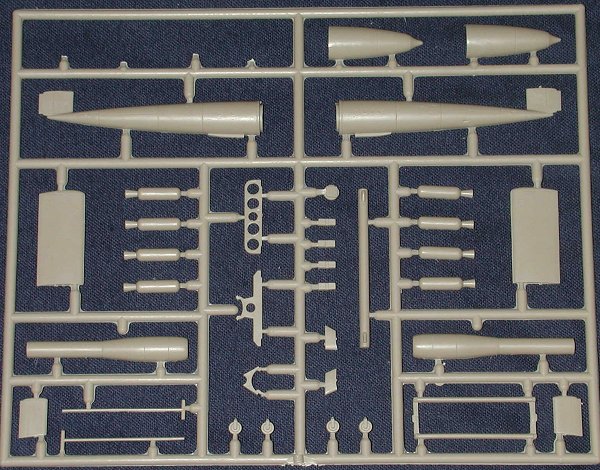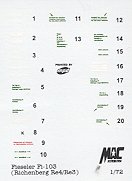
|
KIT: |
MAC 1/72 Fi-103 (V-1) |
|
KIT # |
72042 |
|
PRICE: |
$14.98 ($12.96 at Squadron) |
|
DECALS: |
one missile |
|
REVIEWER: |
|
|
NOTES: |
Short run kit |

|
HISTORY |
The Fieseler Fi-103, more commonly called the V-1, was the world's first operational cruise missile. It was a very crude vehicle, but was also most effective in what it was designed to do. It was basically an aerodynamic bomb powered by a pulse jet. The pulse jet is a very simple engine that requires a minimum speed to operate. Once that minimum speed has been reached, fuel is injected into a chamber in spurts (thus the pulse part of the pulse-jet) and then lit, the controlled burning of that fuel provides thrust. It also gives the missile a very distinctive motor-boat sound while in flight.
Guidance is provided by a gyro and a mechanical devise that determines how far the missile goes before the fuel is shut off and the missile falls from the sky. The number of rotations of a small propeller on the nose of the missile is much of what determines how far the missile travels and this can be preset prior to launch.
Several thousand V-1s were launched during late 1944 and into 1945, most of them aimed at Britain or at Dutch ports. After the war, a number of them were captured and tested by the Allies. In the US, Ford reverse engineered the type and it went into service as the JB-2 Loon. The only way to tell the difference between a German and American version is that the US version has a more vertical forward engine pylon.
|
THE KIT |

MAC provides a single sprue of light brown plastic, a small etched brass fret and a decal sheet. The first thing you notice is the empty space on the upper left of the image. This is for a different nose that you will see in a later preview of the Loon.
As the V-1 is a simple aircraft, this kit is equally simple. The parts are well molded with the now obligatory engraved panel lines. In addition to the missile itself, you get a ground handling dolly, similar to what you get with the Tamiya 1/48 kit, though not quite a tall. You also get the launch platform from the Loon kit, but this is x'd out on the parts sheet and not included in the construction sequence, though I guess you could build it without any real problems. Mounting points for the wings and tail planes are simply small bumps that fit into equally small dimples on the fuselage so a bit of care may be needed when attaching them.

 The
etched fret is for the intake and a few other small bits, such as the nose prop.
I'm not sure about the correctness of the nose, fuselage, pylon and engine as
those items seem to be where most of the experts will have their attention
drawn. As one of the 'if it looks right....' crowd, I can tell you that on the
sprues, it looks OK to me.
The
etched fret is for the intake and a few other small bits, such as the nose prop.
I'm not sure about the correctness of the nose, fuselage, pylon and engine as
those items seem to be where most of the experts will have their attention
drawn. As one of the 'if it looks right....' crowd, I can tell you that on the
sprues, it looks OK to me.
The decal sheet is for this and several other variants of the Fi-103 so it rather generic in nature. As an expendable weapon, there was no national insignia or other markings other than the usual servicing labels. The instructions have four different versions shown. One is all black, one all RLM 71, and one RLM 71 over RLM 65. Another, probably a test version, is RLM 71 upper with RLM 76 lower and the back half of the wings and tail planes in white with a black/white rudder.
|
CONCLUSIONS |
Given the looks of the kit, it looks a whole lot better than what comes with various Frog kits. I cannot compare it with the ProModeler offering or any other 1/72 V-1 as I haven't seen those kits. It appears to be a very nice little kit and one that should be a pretty quick build.
You can find this kit and many others at

If you would like your product reviewed fairly and quickly by a site that has well over 150,000 visitors a month, please contact me or see other details in the Note to Contributors.